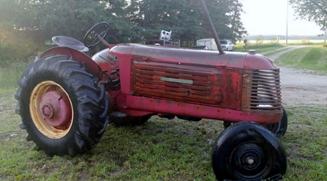
This unique tractor was donated by George and Lorna Webster of Lac du Bonnet, Manitoba. It is complete, including the often-misplaced side panels, and requires only a paint job to be a showpiece.
George tells about the tractor’s history:
“My dad George Webster Sr. bought the Graham Bradley from Consolidated Motors on Main Street in Winnipeg in partnership with my grandpa James Webster. The Bradley was purchased during the spring/summer of 1938. The dealership had a salesperson drive out from Winnipeg to the farm at Sperling, Manitoba. According to my father he arrived in a little over one hour. The Bradley had a very high-speed road gear, very unusual for the era. I believe the purchase price was $1,750. The Bradley was used through the Second World War to farm five quarter-sections of land in the immediate area of my grandpa and my father’s farms in the Sperling area. My dad and his two brothers would shift work on the Bradley. One would get off the tractor, the replacement would fuel it up, get on and go back to work. The Bradley would hardly cool off. They did the seeding and all farm work with the Bradley. It was the only tractor they had. It has worn out numerous sets of tires and at some point, the rear tires were up-sized for traction and I assume better ground speed. It has had a couple of valve jobs and possibly one re-ring. I do not believe the rod bearings have ever been changed in it. The rear differential has never been touched. Prior to going to the museum, it had not been started for 15 years. I put a battery in it and some gas and then tried to start it. It started up almost immediately. When the transport from the museum arrived, we put the ramps onto the trailer and I drove a 79-year-old tractor onto the trailer under its own power. My wife and I were very sad to see it go but we knew it was my dad’s wishes that it go to the Austin museum where it would remain as a functional unit. He knew there were almost no tractors like this in Canada and only a handful in the US. We were fully in agreement for it to go to the museum.”
In 1937 Sears-Roebuck decided to add tractors to their mail order catalogue and retail stores. Rather than simply re-badge a production tractor, they approached the Graham Paige automobile company to build a tractor for them. The Bradley garden tractor company assisted with the design, thus the tractor name. Rated at 25 drawbar horsepower, it used a six-cylinder 217 cubic-inch Graham Paige car engine, built by Continental. The remainder of the tractor was designed by Graham Paige and, for the time, was quite advanced. It came standard with starter and lights, cushioned seat, four-speed transmission, a 20-mph road gear and steering brakes. All gauges and controls were grouped on a styled dash panel.
One of the first tractors to be “streamlined,” its appearance was reminiscent of the sporty cars for which Graham Paige was known. An unusual feature is that the belt pulley is driven from the transmission output shaft, and the differential is disengaged for belt work; this provided four speeds and reverse for the pulley. Selecting the wrong gear may have produced some interesting results depending on the machine being driven. The tractors were advertised as “built by Graham, equipped by Bradley, guaranteed by Sears.”
Unfortunately, Sears decided to stop selling tractors after only about 2,000 were built. Of these, perhaps fewer than 100 were the wide-front Model 104. Without a dealer network, Graham Paige ceased production in 1939. The company suspended automobile production in 1942 to concentrate on war contracts. It was purchased by the Kaiser Corporation after the war and produced Kaiser and Frazer cars. Tractor production never resumed. Today, Graham Bradley tractors are somewhat rare, and this one is even less common, being the “Wheatland” Model 104 rather than the more common tricycle row crop. Fewer than 30 may be left in existence.


